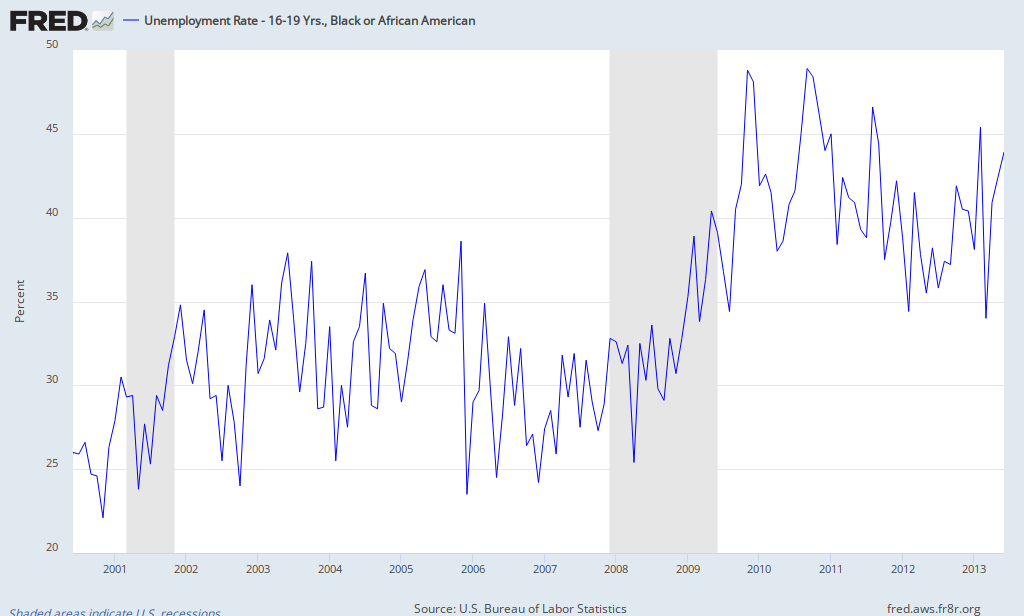Enlightened opinion holds that legalizing drugs (at least some drugs, e.g., marijuana) will reduce the catastrophically high American incarceration rate. As Fareed Zakaria wrote last year in Time magazine:
Over the past four decades, the U.S. has spent more than $1 trillion fighting the war on drugs. The results? In 2011 a global commission on drug policy issued a report signed by George Shultz, Secretary of State under Ronald Reagan; the archconservative Peruvian writer-politician Mario Vargas Llosa; former Fed Chairman Paul Volcker; and former Presidents of Brazil and Mexico Fernando Henrique Cardoso and Ernesto Zedillo. It begins, “The global war on drugs has failed … Vast expenditures on criminalization and repressive measures directed at producers, traffickers and consumers of illegal drugs have clearly failed to effectively curtail supply or consumption.” Its main recommendation is to “encourage experimentation by governments with models of legal regulation of drugs to undermine the power of organized crime and safeguard the health and security of their citizens.”
As Zakaria observed, “The U.S. has 760 prisoners per 100,000 citizens. That’s not just many more than in most other developed countries but seven to 10 times as many. Japan has 63 per 100,000, Germany has 90, France has 96, South Korea has 97, and Britain–with a rate among the highest–has 153. Even developing countries that are well known for their crime problems have a third of U.S. numbers. Mexico has 208 prisoners per 100,000 citizens, and Brazil has 242.” For African-Americans, the rates are terrifyingly high. In an earlier post I quoted a Pew Institute survey noting that “more African American men aged 20 to 34 without a high school diploma or GED are behind bars (37 percent) than are employed (26 percent).”
Why should decriminalizing drugs, though, reduce crime? Criminals do not get involved with drugs because they like drugs, but because they like crime. They tend to be young, unskilled, and marginalized and unlikely to earn a living in the legal economy, while the illegal economy offers them opportunities–especially for those who hold their lives cheap.
The overall unemployment rate for Americans aged 16 to 19 years has reached levels not seen during the postwar period:

It’s considerably worse for minorities.

45% of blacks aged 16-19 presently are unemployed, up from 25%-30% during the two George W. Bush administrations. Enormous numbers of young Latin Americans are unemployed as well; it is estimated that the Mexican drug cartels employ 500,000 of them. Decriminalizing marijuana would give a windfall to cigarette manufacturers, for example, but erase the income available to young, unskilled unemployed Americans. If they can’t make a living selling pot, they will sell whatever drug we continue to criminalize, or engage in some other form of remunerative criminal activity, just like the Mexican cartels, who are as happy to make money through kidnapping (for example) as through drug sales).
Is this the inevitable fallout of global economic forces that have made redundant (to use the awful British euphemism) the least-capable among America’s young people? That is the historical pattern. The usual historical solution is to kill off the redundant population, as I observed in a 2011 Asia Times essay.
The Industrial Revolution improved the lives of British workers by every available measurement – life expectancy, consumption, and so forth. But that was true only for those who survived the agricultural revolution to become industrial workers. The agricultural revolution that prepared the industrial revolution displaced a large proportion of agricultural labor. Starvation, emigration and war consumed the redundant population.
The Napoleonic Wars alone killed 188,000 British men, in a population of less than 9 million, the equivalent of 6.3 million in today’s American population. An additional 225,000 were transported as criminals to America (60,000) and Australia (165,000), not counting perhaps 1 million voluntary emigrants during the 19th century from England, Wales and Scotland.
Altogether, the attrition rate of the English and Welsh population at the turn of the 18th century amounted to 15%. Scotland must be considered separately, because the English deliberately cleared the Highlands of people after the 1746 Stuart rebellion. About half a million Highlanders were displaced, almost a third of the Scots population. Whole villages were transported to North America.
America’s prisons are doing today what the Napoleonic Wars, the Australian prisoner transport and the Highland Clearances did during the 18th century: get rid a large part of the population. That is a horrible observation, but a logical one. Blacks are the worst affected. The Second World War opened up high-paid industrial jobs previously reserved for whites. And the decline in US industrial employment starting in the 1970s reversed this. The dying city of Detroit is the image of African-American economic status. It is not just African-Americans who are suffering, to be sure. In social pathology of all kinds, the general population is only a bit behind the minorities, as Charles Murray argued persuasively in his 2012 book Coming Apart.
What shall we do? Decriminalizing drugs will not solve the problem. It will only transfer young criminals from one sort of criminal activity to another. We frequently hear the complaint that tough anti-drug laws incarcerate too many non-violent offenders (that is, offenders who were not caught in acts of violence and convicted). If our policy is to exhaust the potential population of criminals through attrition–and that is what it amounts to–the present state of affairs is as good as it gets, for it means that we are incarcerating the criminal population before violent crimes are committed rather than afterwards.
The hypocrisy attending the de facto war of attrition is transcendent. The youth unemployment rate has doubled on Obama’s watch, from around 12% to around 25%, and minority unemployment in particular has soared. Obama has done more to shrink the number of entry-level jobs (by forcing employers to offer health insurance) than any other person in American history. We have put an enormous fraction of America’s young population on the scrapheap, and our fallback is the Scrooge solution, namely prisons and workhouses. One would hope that young people, even those without good economic prospects, would sustain a hope for something better. But thug culture has had done so much damage to morale that things are getting worse, faster.
For some years I have argued that America needs to revive the Depression-era idea of a Civilian Conservation Corps and similar entities to get young people working. That may seem a distinctly un-conservative proposal from a right-winger like me, but drastic measures are required. It costs nearly $50,000 to incarcerate a prisoner in the State of California, for example. Giving kids jobs doesn’t necessary reduce the prison population, but at the margin it ought to help, at less than half the cost. We should try something beside the Scrooge solution. Obama won’t do anything like this because the construction unions would object.
In the meantime, there’s no benefit to be had from retreating on drug enforcement.










Join the conversation as a VIP Member